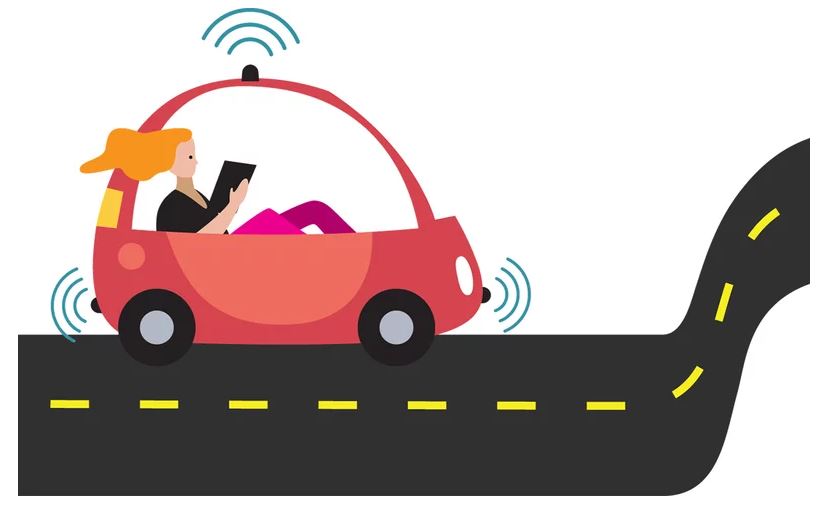The advent of autonomous vehicles, and in particular for personal use, has already had measurable impacts on our societies.

The impacts can be seen in a number of areas:
- New road construction, and updates to existing road construction, now take into account the need to provide supporting infrastructure for autonomous vehicles.[1]
- Most US states, and many countries, have put into place and continue to update standards, regulations, and programs to support the use of autonomous vehicles on public roads.[2]
The work is in these areas is well-covered in a number of websites and posts: see the notes at the end of this blog for some links.
I am interested here in sharing some thoughts I’ve had that may not have been well-covered in the literature but which are of interest to me in terms of the positive and negative impacts these may have on infrastructure, culture, and how we handle the new legal issues that would arise.
Infrastructure should change
The current roadway infrastructure in most of the world is predicated on the behaviors expected of human drivers and attempt to minimize the opportunity for accidents while maximizing “throughput” of the system. This is best seen in the age-old problem of dealing with intersecting roadways, where traffic control of some kind must be instituted to avoid collisions and allow pedestrians to cross safely (where appropriate). This is usually accomplished by some combination of stop signs, yield signs, traffic signals, and traffic regulations controlling expected behavior at such intersections.
With such an existing infrastructure, massive when considered on a world-wide basis, and the fact that autonomous vehicles must mix with human-driven vehicles, it’s not surprising that most autonomous vehicles are programmed to live within existing infrastructures and rules.
For example, current autonomous vehicles that operate on surface streets are expected to recognize and properly respond to traffic signals and traffic flow control signage. They must, as there are human drivers that flow with them and abide by the same rules.
Further, as current autonomous vehicles are generally lower than class 5 (“full driving automation”–i.e., no steering wheel or manual brakes), until these are the majority (or all) of on-the-road vehicles, this is not likely to change.
But let’s imagine for a moment what could (and perhaps should) change if no vehicles other than class 5 are allowed on some, most, or all public roadways.
At this point, the restrictions that apply when there are non-autonomous vehicles in the mix may be completely eliminated or severely restricted in location or extent.
For instance, intersections would no longer need infrastructure-related flow control mechanisms–the vehicles themselves could contain this information. In-vehicle street maps would contain specifics on the details of an intersection (width, number of lanes, turn vs straight-ahead lanes, etc.) that would be needed to make stop/go/speed decisions. Additionally, with the inclusion of between-vehicle networking, the cars and trucks could decide dynamically who should have the right-of-way, at what speed the intersection should be traversed, and so on to maintain the optimal flow rate of the traffic.
Some interesting work has been done in this area by a team at Cornell University [3] in which they modeled the idea of having “platoons” of vehicles–tightly clustered cars that travel together–that are allowed to pass through an intersection while cross-traffic is held. This differs from human-piloted vehicles in that the cycle time of the stoplights can be faster to provide shorter hold times for the cross-traffic. Throughput increases of up to 138% are possible with this approach.
Let’s go a little further with this idea. What if the following were true?
- Traffic lights were removed/deprecated at an intersection.
- All autonomous vehicles approaching an intersection were in constant communication.
- Common decision algorithms based on dynamic inputs (other vehicles, weather, desired flow rate, existence of approaching pedestrians, etc.) were used by all vehicles.
- Platoon sizes as low as one vehicle were permitted.
I can foresee–though I have no direct proof through modeling, for instance–that even larger throughput increases could be achieved.
Certainly one obvious advantage to be achieved from such an approach would be the removal of the need to install and maintain traffic control mechanism–bulbs that need to be replace, signs that must be replaced after being damaged, etc. Infrastructure costs could be reduced or, at the least, be available for redirection to more meaningful efforts such as the maintenance of roadways themselves.
This approach is not without its downsides or costs, of course.
- There must be industry-wide agreement on decision standards for the dynamic flow control of such vehicles.
- There cannot be more than a few, if any, non-fully-autonomous vehicles on the roadway.
- Legal issues around where responsibility would lie for any problems would have to be resolved and codified.
But, all in all, I would argue that conversion of the flow control systems in public roadways to an in-vehicle, shared system would permit maximal use of public roadways in the world in which human-operated vehicles are the exception rather than the rule.
[1] Many countries are establishing standards for roadway markings, for instance, to meet the needs of autonomous vehicles. These include reflectivity standards for paints, minimum widths for lane markers, etc. See this interesting article for some background.
[2] Ibid
[3] https://news.cornell.edu/stories/2019/12/smart-intersections-could-reduce-autonomous-car-congestion